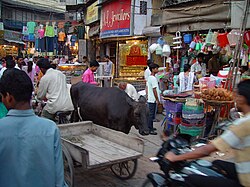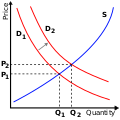Microeconomics
Microeconomics is the science of how people make decisions at the small scale. It is different from macroeconomics which looks at how the economy works as a whole ("on aggregate").[1] In microeconomics, we might look at how a person chooses what to buy at the store, or how many things a company will make. Some parts of microeconomics include Consumer Theory and Theory of the Firm, which study how people and businesses make decisions. Game theory looks at how people make decisions when the outcome (how something ends) depends on what decision another person makes; when agents are said to act "strategically".
Microeconomics Media
Microeconomics analyzes the market mechanisms that enable buyers and sellers to establish relative prices among goods and services. Shown is a marketplace in Delhi.
The supply and demand model describes how prices vary as a result of a balance between product availability and demand. The graph depicts an increase (that is, right-shift) in demand from D1 to D2 along with the consequent increase in price and quantity required to reach a new equilibrium point on the supply curve (S).
United States Capitol Building: meeting place of the United States Congress, where many tax laws are passed, which directly impact economic welfare. This is studied in the subject of public economics.
References
- ↑ Krugman, Paul; Robin Wells with Margaret Ray and David Anderson (2012) Microeconomics: Second Edition in Modules Worth Publishers New York, New York page 5


